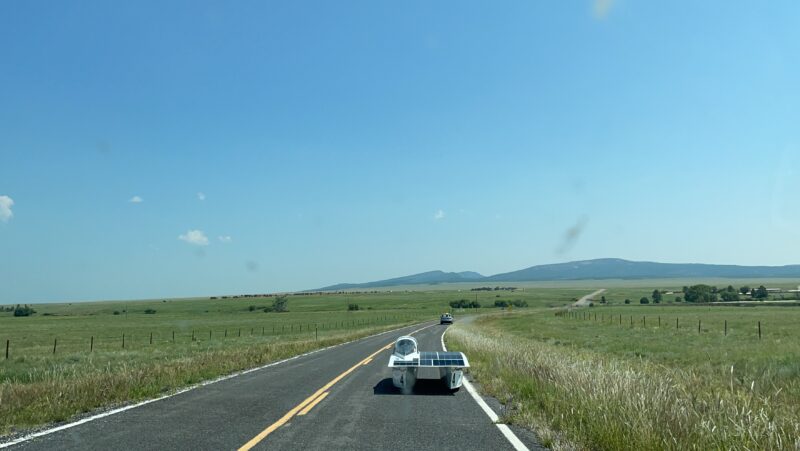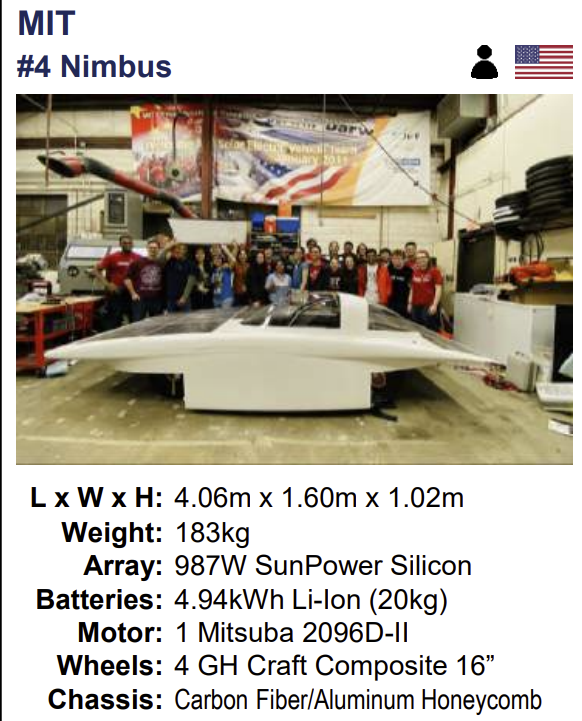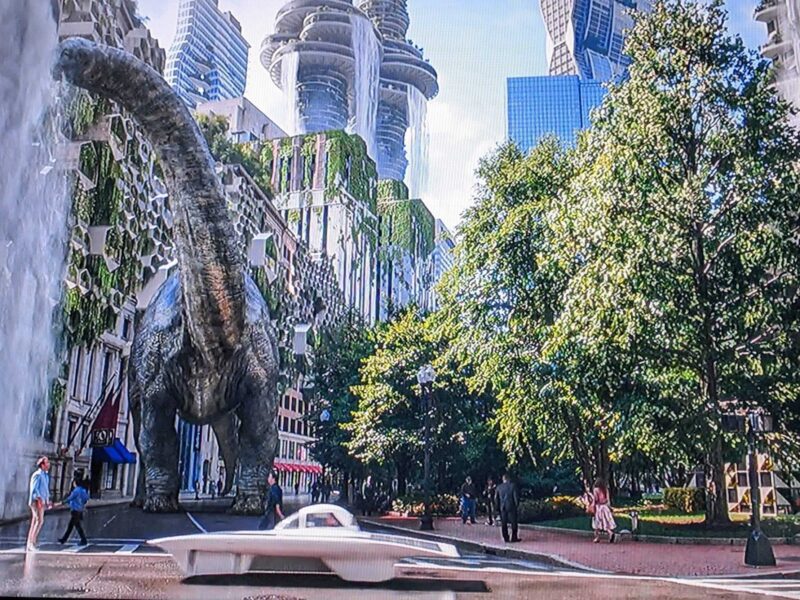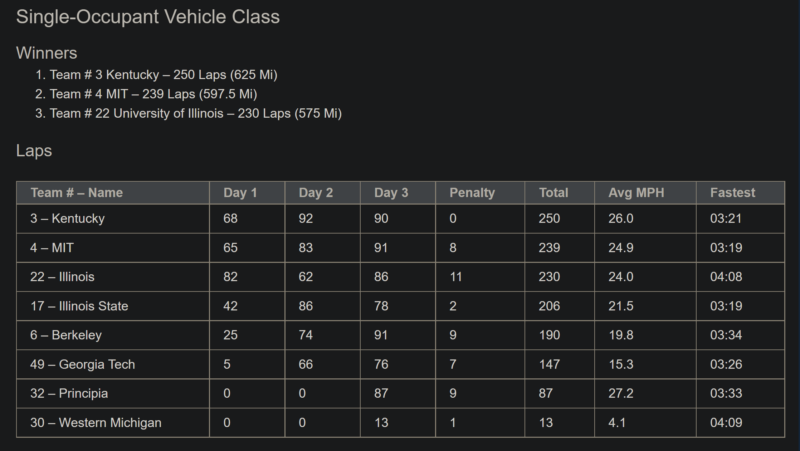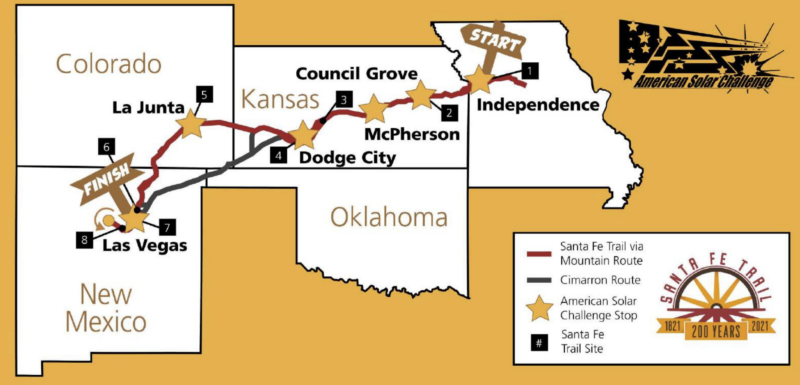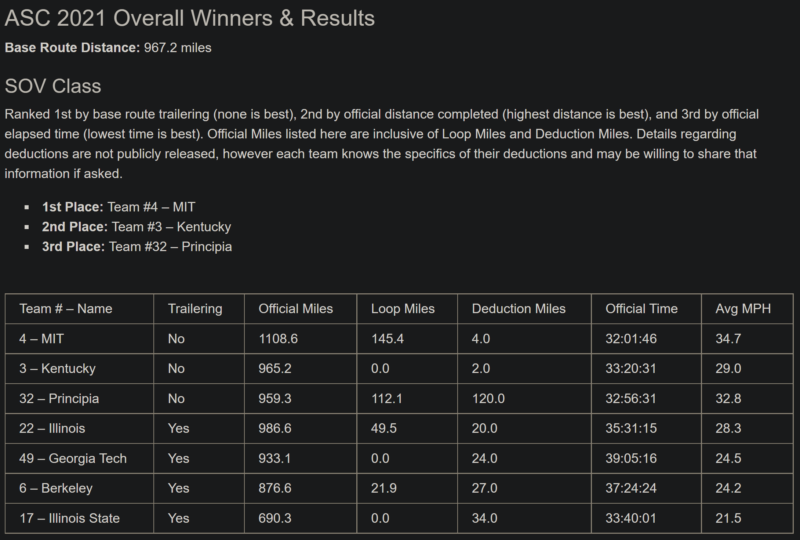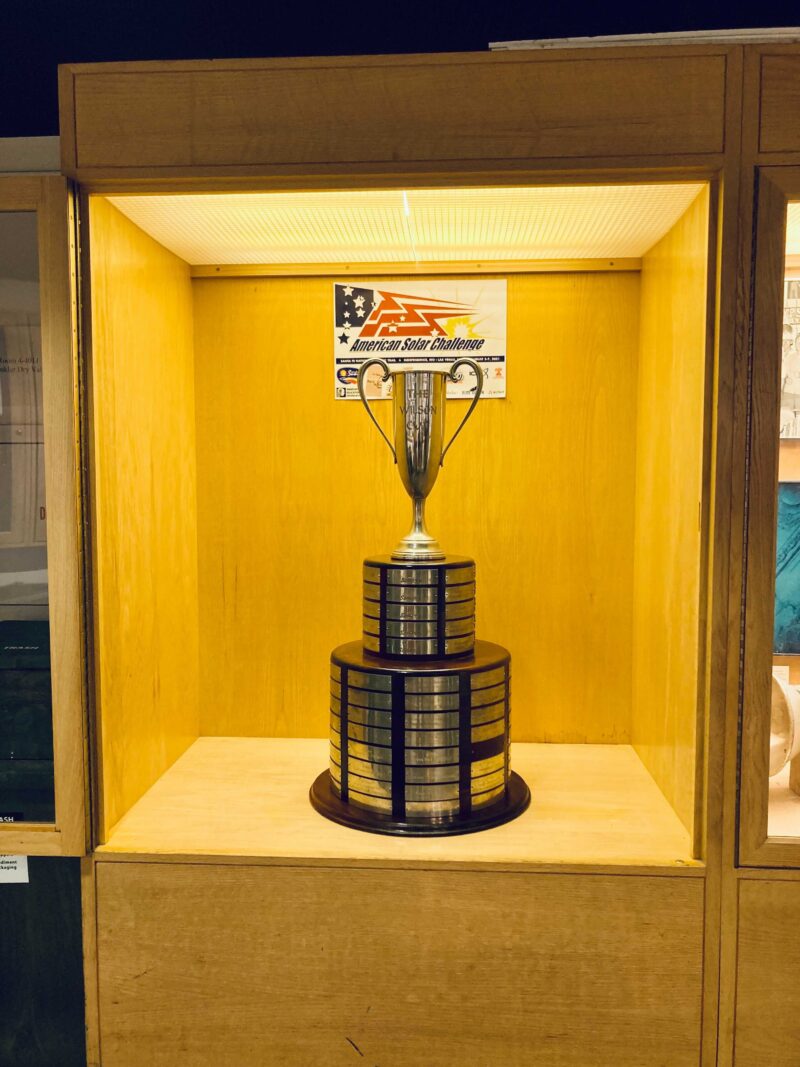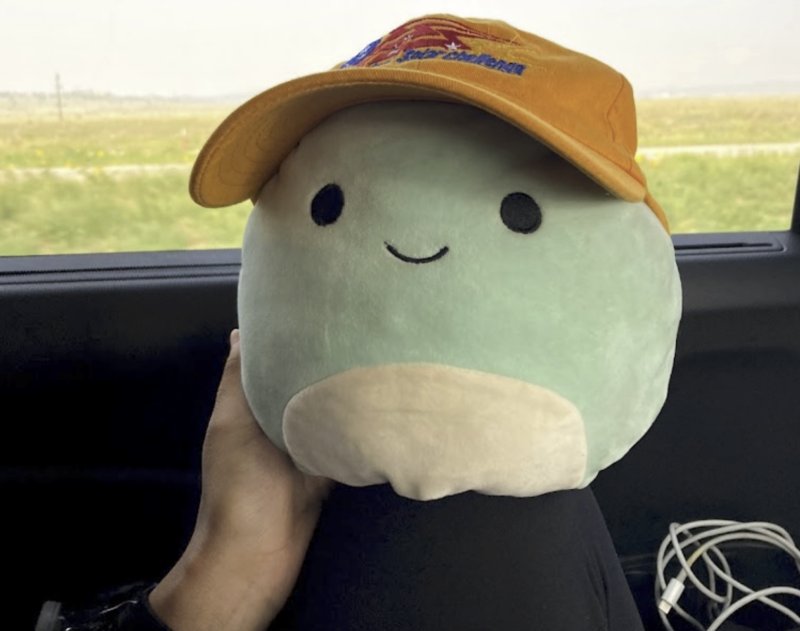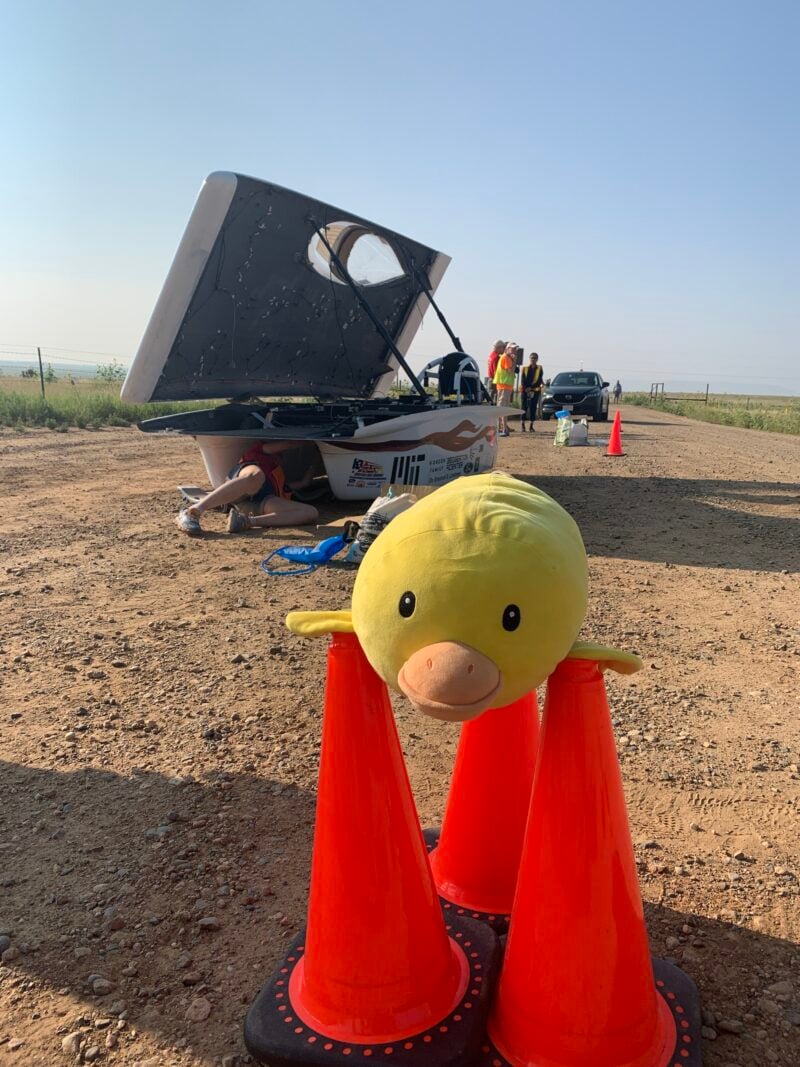
[Joint Post] Avoiding Sunstroke by Waly N. '24
Solar Cars, Solar Stories, Solar Blogs
So. It’s been a while since I last was on the blogs, speed writing about a new experience.
During my writing hiatus, over this past summer, I did a thing. And it was a pretty cool thing to be a part of if I do say so myself. As part of the Solar Electric Vehicle Team (SEVT), I went to the American Solar Challenge (ASC), where our team raced our solar car, Nimbus,01 What a good girl across central-ish America.02 not sure because the midwest isn't even really in the middle/west of America... There were two components to the event, the Formula Sun Grand Prix (FSGP) and the official race, the first of which I wasn’t present for because I had to work my job(s) on campus.
I think it was fairly obvious to me that this experience had to be blog-worthy content, but I wasn’t at all sure how to write it. I wasn’t there for the whole time, to begin with, as I arrived about 4-5 days into the event, just before the official start of the race, around 1am. I didn’t feel the event would get the spice it deserved if I summarized it like a bland Wikipedia article.
A bit after the race, one of our team’s members mentioned how Alan03 who I kind of stole the blog from, oopsies (yes blogger Alan) was interested in having the team write a post about the American Solar Challenge for the admissions site. Which made me think, wouldn’t it be cool if people could write many stories about tidbits of the journey? I mentioned wanting to write an ASC blog during the race itself to one of our media leads and the legendary brakes czar, Rebecca ’24, but I was no thoughts, head empty on how to approach it.
Making this blog was a bit of a struggle, as I’ve tried to write joint posts before, but none have really taken off the ground, and even this one spent quite some time taxi-ing on the ground before it got to depart. But ultimately, I’m happy to post it, and share some first-hand stories from the people and team that made ASC so great :)
Buttttttt before we get into that, let me give you some background info to help these stories make some sense, even with the usage of solar car jargon. Also, as a disclaimer, everything that happened in these stories is based on real people and events, so even if you read a certain story and believe, ‘hm, this seems like fiction,’ I can assure you it is not :)
Background Info (Not really a story lol)
Let me start off this quick04 it will be quick, he lied. crash course by giving a formal introduction to Nimbus, our pride and honor. She is a single occupant, street-legal solar car from Cambridge, Massachusetts, made of a carbon fiber, aluminum honeycomb chassis, and the result of 3 years of hard work. She was originally supposed to race in the 2020 American Solar Challenge, but a panoramic happened, which pushed the race to 2021. For those of you more technical folk, Nimby was car #4 at ASC 2021, and is about 180kg, 4 meters long, uses a 987kwh SunPower Silicon Array, and operates on single-wheel drive.
The driver in Nimbus has to meet some height requirements, such as being under 5’ 7’, though weight doesn’t really matter, as a ballast is added to the car to standardize weight during competitions. Nimbus is built taking aerodynamics and efficiency into mind, so you won’t see a speaker or luxurious AC in our car, though you will see our array of pretty solar panels on top harvesting energy from the sun. If you are ever around the area, you might get the chance to see Nimby training for her next race, going down the Harvard Bridge, or see another MIT solar car in a major motion picture:
So now, about those event components, I mentioned earlier. I threw the term Formula Sun Grand Prix and talked about the official race, and gave no mind to explaining what any of these were. Basically, the former was FSGP, which was a 3-day race/qualifier. All teams were put to the test in scrutineering to prove that their solar cars could pass all the required safety tests, keep the driver safe, perhaps a bit hot but alive, and would not cause a pile-up on a random highway in Kansas. After cars pass all the safety tests, they get to participate in the race portion which is basically driving around a track and making laps, optimizing for speed, and making enough laps over 1 or 2 days to qualify for the official race. It took place at the Heartland Motorsports Park in Topeka, Kansas, and the team made the drive there from Boston on July 24th. I have no first-hand testimony for this event, but let it be known that our now-captain Cameron ‘23 made the fastest lap at the event, taking 3 min, 19 sec while driving 45.2 miles per hour. By the end of this portion of the race, we finished second behind the University of Kentucky, making 239 laps around the track. For reference, each team had to make 82 laps in one day, or 124 in back-to-back days to qualify for the official race, so we did rather dandy I would say.
After this, we moved on to the official portion of the race, which started in Independence, Missouri, at the start of the Santa Fe Trail, which was a historical trading route that led to, you would never guess it, Santa Fe. The team was split into many cars, like a lead/chase car for protecting and directing the solar car, a scout car to report on traffic hazards and weather conditions, a media car for recording the race’s happenings, cupcake, a car that carried supplies to prevent solar car scurvy, and our truck and trailer. We were supposed to start 2nd as a result of finishing 2nd in the qualifiers, but some things are just not meant to be, and we arrived a few minutes late to the race start and got pushed to the last spot. It wasn’t very long before the very same Cameron from earlier put on the gas, and passed every other team before the first stop of the day.
Overall, the race was overall 4 days long, and each day had a checkpoint, stage point, and some days had optional laps your car could do for funsies and a better shot of winning the race. Since the race counted how many miles you were able to drive total, including loops that had start/close times, every team wanted to maximize miles/number of loops made. Though all the teams had to also consider how to keep the battery of the car at a constant level and where to rest for each day, since you were only allowed to charge your cars with the sun. Following the Santa Fe trail, the stops this year were in Council Grove, KS,05 Home to Flint Hill Books, the nicest bookshop I've ever been to Mcpherson, KS, Dodge City, KS, La Junta, CO,06 Nimby, I don't think we're in Kansas anymore. Also, the geography nerd in me feels compelled to tell you, this used to be the southern border of the US Las Vegas, NM,07 Not the Sin City you are thinking of... Santa Fe, NM, and Las Vegas, NM, with optional loops in Mcpherson and La Junta. Before you are like ‘Waly, proofread your blogs better, you repeated a city’, trust me, what I wrote was right, Santa Fe didn’t want 15 solar car caravans stopping in their town, so we visited and hit the dip. We stayed some places overnight, where we either camped or stayed in a hotel, and we spent some time practicing for potential bear attacks. Despite our training, we would have been very screwed if a grizzly came by.
Our car, Nimbus, made it through the whole 900+ mile race over the course of a bit under a week, with an additional 145 miles of laps, for a total of slightly over 1100 miles driven. By the end of the race, we took first place, a pretty trophy, and got mailed a felt pad for the bottom of our trophy in the last few weeks.
Though it sounds and is cliche, the race was really more than the outcome, and the journey the whole way is as memorable for me as the moment on the podium, so I pass on this blog to the writers of these amazing stories from our team. Happy reading!
Get Out of Kansas Free (Pulled Over in a Solar Car) – Sydney ‘24, vice cap
Let me set the scene.
It’s the second day of the American Solar Challenge. We are driving through Kansas toward Dodge City in caravan formation, meaning that the solar car is surrounded by two large SUVs with flashing lights and excessive signage. We call these cars “lead” and “chase” because one of them leads the solar car, while the other chases it.
I am driving the solar car. It’s 90 degrees outside, which means I have to wear a full-face motorcycle helmet. It’s a normal race day––I’m driving down the highway at 45mph, passing a couple dozen semis and smelly cow-filled trucks, and seeing nothing but corn for miles and miles.
Suddenly, through the multiple layers of motorcycle helmet padding, I hear the sound of emergency vehicle sirens.
“Chase to caravan, chase to caravan,” the radio crackles in my ear. “Pull to the shoulder for emergency vehicles. Target speed two-zero, two-zero. Over.”
The caravan follows chase’s instructions, maintaining a speed of 20mph rather than stopping to conserve energy. But the sirens don’t stop. They don’t pass us. In fact, they pull up behind us and follow us. The sirens are there to stop us.
“Chase to caravan, chase to caravan, we are stopping. Stop. Stop. Over.”
For context, when I’m sitting in the solar car, I can’t see behind me. There is no rearview mirror, and what would be a window is blocked by a headrest and a license plate. To combat this issue, the electrical engineering subteam had installed a nifty little backup camera on the car (thanks, EE) but today, in the blazing Kansas sun, the glare on the dashboard screen makes using the camera impossible.
So, we’ve just been pulled over by the Kansas police, and I’m sitting in the solar car, unable to see or hear anything.
“Solar car to chase, solar car to chase,” I say into the radio. “What’s going on?”
“Chase to solar car, chase to solar car, don’t worry about it, you didn’t do anything wrong.”
For me, there is nothing to do but wait. I engage the parking brake and proceed to fiddle with the built-in sunglasses on my motorcycle helmet for the next 16 minutes for entertainment.
At this point, one of the police officers approaches chase.
“I need to see the vehicle registration for––for––that thing,” she says, motioning at the solar car. A reasonable request, I suppose, given that it looks like we are driving a futuristic boatspaceshipcar down the highway.
My teammates pulled up the registration on one of their cell phones.
“What is that?” she asks. “It’s electronic?!? I need a paper copy.”
We, of course, don’t have a paper copy. Oops. The officer then asks for my driver’s license.
Now, envision me, not knowing what’s going on, squinting into the display for the rearview camera when static blasts in my ear.
“Chase to solar car, do you have your driver’s license on you?”
“Solar car to chase, no, it’s not on me, but it’s in my wallet in the rear left door of lead.”
“Chase copies, thank you.”
This is the first time I get a glimpse of the police officer. She’s wearing cowboy boots, and her hair is in a bun too tall and high to be structurally stable. The way she walks sends one clear message: this is her highway.
She collects my license from lead, then turns and positions herself about two feet from me. She holds up my license and looks back and forth from me to the photo of me. It’s like a really intense version of airport customs, when they glance from my face to my passport twice before stamping it. Except there are some key differences here.
First, this goes on for three minutes. That is not what happens in airport customs.
Second, I am fully encased by a sizable aircraft acrylic bubble windshield. I can tell the police officer wants to ask me to roll down my window, but she simply does not know how to ask such a question.
Third, and perhaps most importantly, I am wearing a full-face helmet with built-in sunglasses and a polycarbonate shield pulled all the way down. So, truthfully, I’m not sure what she’s looking at. I am completely unrecognizable.
Yet she stands there for an extended period of time before finally walking back to chase, where she asks to look at the vehicle registration again.
“This expired two days ago,” she says after reading the (electronic) document.
My teammates explain that although our vehicle registration expires at the end of July, we registered the car in Massachusetts, where there is a seven-day grace period before it is illegal to drive the vehicle. This seven-day grace period is more than enough to cover the duration of the race. In Kansas, however, such a grace period is absolutely unheard of.
“This is an arrestable offense!” she says, threateningly.
Honestly, I would have loved to have video footage of this police officer removing me from the solar car with that full-face helmet and arresting me on the side of the Kansas highway before extracting my nine teammates from lead and chase and arresting them, too. But that didn’t happen.
While Police Officer 1 is reprimanding the occupants of the chase vehicle, Police Officer 2 appears in my rather limited peripheral vision, tries to have a conversation with me, and starts taking photos of the solar car.
In retrospect, what was going on here? One police officer is threatening to arrest me while the other is treating me like a tourist attraction.
“Chase to caravan, chase to caravan, we’re good to go. Let’s go,” I hear over the radio. I disengage the parking brake, and we pull back onto the highway, relieved.
To make up for the 16 minutes we lost to the Kansas police, the American Solar Challenge officials kindly extended the subsequent race day. As for the officers, they certainly kept themselves busy by pulling over every other solar car team behind us.
‘Running antelope’ – Annemarie D ‘22, Aero
The ASC route is always planned in coordination with the National Parks Service. This means we always travel through some gorgeous locations and stop by interesting historical and natural landmarks, and this year was no exception.
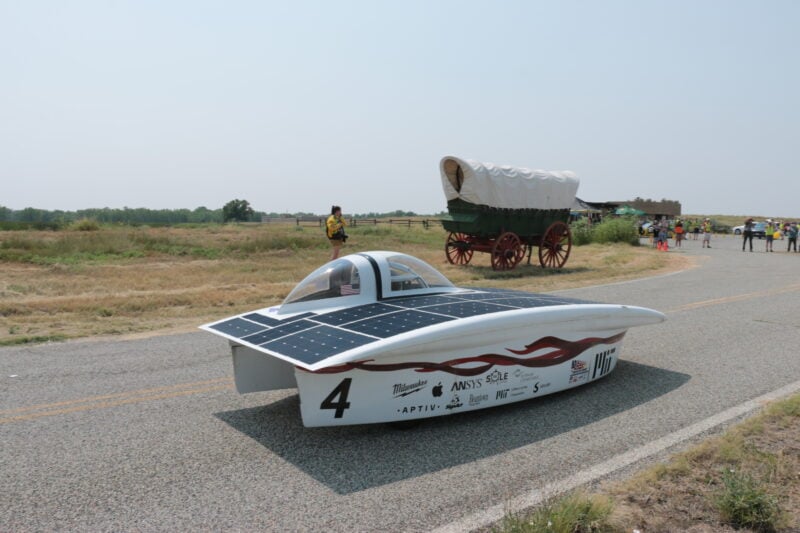
Nimby pulling into a stage stop. You can see a historical fort in the distance, and there was a covered wagon as well to highlight to the public how this trip was once made in covered wagons, and now we’re doing it in cars powered by the sun!
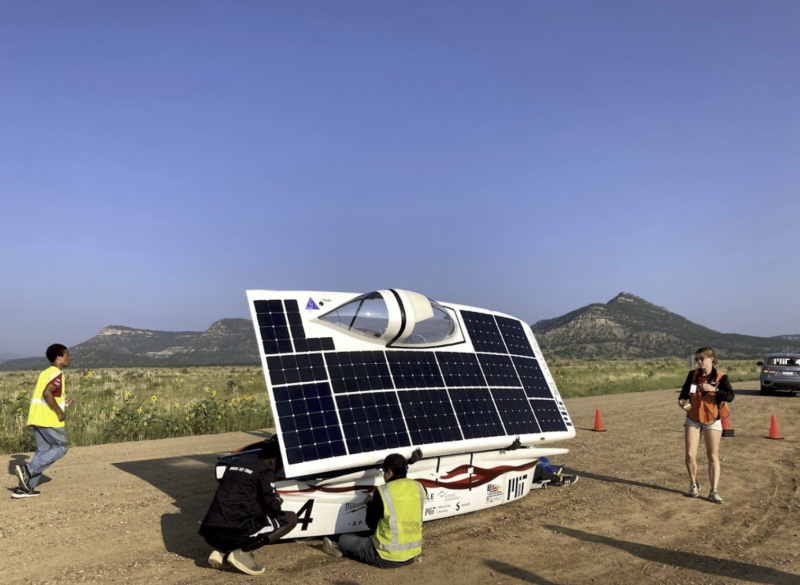
Morning charging in picturesque New Mexico. It was stunning out there – New Mexico was definitely the best state we traveled through on the race (apologies to Missouri, Kansas, and Colorado). This was a particularly good day as there wasn’t a cloud in the sky – we were able to get a lot of solar energy and perform really well.
My role in the caravan was as a Chase vehicle driver. Now, Chase is known as the chaos car of the caravan since our most important job is to protect the solar car at all costs. This means being a bit of an ***hole on the road, as Chase needs to drive aggressively through intersections and on the highway. Chase takes up extra space in the lane to ensure other cars avoid hitting the solar car since it’s so low to the ground (no semi driver is going to be able to see Nimbus from high up in the cab until it’s too late, and same goes for people not paying enough attention at intersections). Race officials swear that the best Chase drivers come from Boston, so we had a slight advantage here!
The passenger seat of Chase is occupied by a member of our MechE subteam whose job is to assess and potentially fix damage to the car should something go wrong and operate Chase’s radio and communications, while the backseat is the home of telemetry. Jenny Z. ‘23 and Julian Z. ‘23 were in charge of our telemetry, perched in the backseat with an array of laptops and their MIT-sponsored iPads, yelling out and debating target speeds, and sometimes driving me crazy asking to slow down so they could stick some sensors out the window to check sunlight. Hey, I needed to stick close to the solar car! The final seat in the back is home to a race volunteer known as the observer. Their role is to ensure solar car teams don’t break any rules, including speeding on the highway or charging the car outside of race hours. Our observer was a chemistry professor named Keenan whose daughter competed with Illini solar car when she was in college. He seemed a bit wary of us at first, what with all our sun summoning dances (more on this in Jenny’s following section), yelling about “nooky-nooks” (our term for isolated right-turn lanes separated by a raised median, usually triangular), or placing Diane L. ‘22’s stuffed lizard, Liz, in random locations. He eventually warmed up to us and our hijinks however, even participating at times!
However, sometimes on we’re getting plenty of beautiful New Mexico sun, there aren’t many cars on the road, and we’re cruising at the lead of the race. When that happens, the attention of the now-calmer Chase turns to the incredible scenery outside. We’d been tracking all the different animals we saw on the side of the road, and as we’re driving down the highway we notice some new ones in the sweeping fields. They’re smaller than deer, with with patches and gorgeous antlers. We were debating what these beautiful creatures are, when Keenan spoke up: ‘They’re antelope.’08 Technically they weren’t antelope. I later learned that antelope are not native to the Americas and these animals were pronghorns, a native species very similar to antelope and often commonly referred to as antelope or “pronghorn antelope.” For the sake of this post, I will simply call them antelope as that’s what we used on the race. ”
Antelope??!?! I had never seen an antelope before! We all started eagerly pointing out antelope whenever we saw them on the side of the road. Julian counted every antelope we passed, and Jonathan R. ‘24, who was the radio/MechE on call that leg, would call it in to Lead over the radios.
“Chase to Lead, Chase to Lead, there is a group of three antelope on the left”
“Lead to Chase, repeat?”
“Chase to Lead, we repeat, there are three antelope!”
One more thing to note is the observer keeps a slightly intimidating clipboard with them always. This is where they would record our start and stop times, rules violations, and any important occurrences that happened on the road. Keenan always had it in his lap, tracking our progress.
As we continued driving, we spotted a new antelope occurrence: running antelope! They were leaping through the tall grass, absolutely gorgeous and graceful. Jenny noticed Keenan scribbling on his clipboard. We were going well below the speed limit, and there were no other cars in sight – what could he possibly be writing down? She stole a surreptitious peek at the clipboard.
“Keenan, did you actually just write down ‘running antelope’ in your notes?” Jenny questioned.
“Of course, it’s a landmark!” Keenan responded.
The entire car promptly burst out into laughter. And, for the record, Chase beat Lead in the number of antelope spotted on the side of the road.
Chickens SI unit – Jenny Z ‘23, EE, systems lead
Anyone familiar with MIT lore will know that we have some pretty weird custom units floating around. Smoots, anybody? Smoots at least makes sense, since any sane distance unit can be converted to good ol’ meters (metres). The unit I shall tell you about today is not worthy of being an SI unit, therefore we are classifying it as imperial.
Day 2, as you know from Sydney’s delightful Kansas police story, was kind of rough in terms of almost getting arrested. Unfortunately, that day was also cloudy and started raining at the end, meaning it was a sad, sad day of solar array charging as well. We were crawling at 15mph on a 70mph highway for about 2 hours, which isn’t exactly ideal. During evening charge, the team performed a sun-dance,09 The opposite of a rain-dance in the hopes that it would summon good weather for the next day.
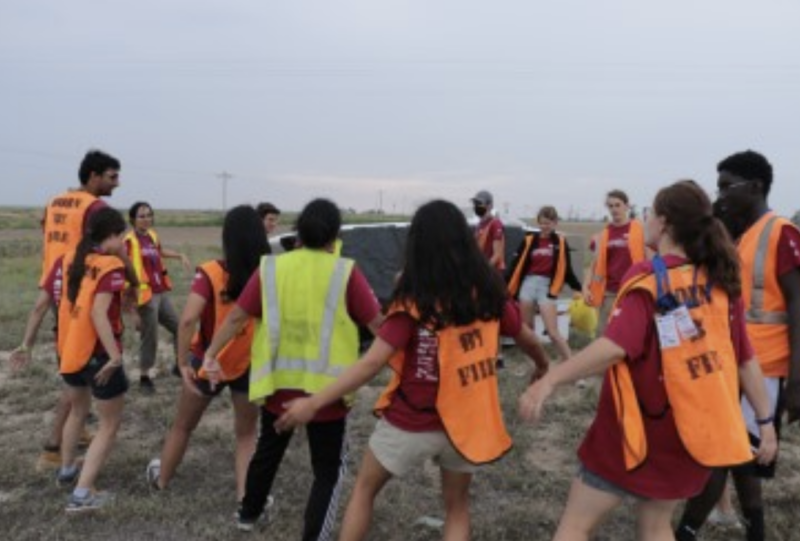
Figure 1. On a cloudy evening during the American Solar Challenge, we perform a dance to encourage the sun to emerge to charge Nimbus’ battery.
It’s 5AM the morning of Day 3 on the American Solar Challenge, somewhere near the border of Kansas & Colorado. I’m part of the morning crew that wakes up early to get the car ready before we get on the road, and we’re hoping for a good morning charge so we can “no gas zoom zoom” for the rest of the day. Looking up sleepily at the sky, I’m delighted to realize that there don’t appear to be any clouds visible, and tell Adi,10 Our retired team captain “Look, the moon is super bright and clear, that’s a good sign for morning charge!”
A pause. “Let’s not count our chickens before they hatch. We have literally a single chicken at the moment, and that is mostly hope.”
Well that was slightly disheartening, but we didn’t lose hope. We have a single chicken, that’s got to count for something!
Fast forward to 7AM, we’ve taken the battery out from the impound box,11 The race official traveling with us on the race (Keenan) who makes sure we follow regulations and traffic laws watches us lock our battery pack into an impound box every night to make sure we don't secretly charge it off the wall during the night. put it into the car, plugged everything in, tilted the solar array toward the East, and are staring at the dashboard12 This component displays information like voltage of the battery, current going in from the array and out to the motor, and velocity of the car. to see how many amps we are getting. I’m happy with the number that pops up: “Yaaaaayyyy we’re getting 3 amps13 At noon on a nice sunny day, we can get to about 7 amps, and when the sun is lower in the sky and there is some amount of morning fog, 3 amps is a very good number. and the sky looks clear as per eyeballs and the weather report! Do we have more chickens now?”
Adi is as cautious as ever: “Hmmmm let’s tentatively say 3 chickens.”
The drive on Day 3 went smoothly, and we were making very good progress along the race route, ending exactly where we wanted to be for the overall race strategy. Julian14 The other strategEE sitting next to me in the chase vehicle and I report to the lead car over the radio: “Chase to Lead, strategEE estimates we now have 5 chickens, 5 chickens, over.”
The response we get is bordering incredulous: “Lead to Chase, are you suuuuuuuure??”
“Affirmative Affirmative :)”
“YAAAAAAAAAYYYYYYYYYYY”
Now that we have a generic gist of how this chickens unit works, here is a beautiful graph of the ASC 2021 MIT SEVT Chicken Audit!
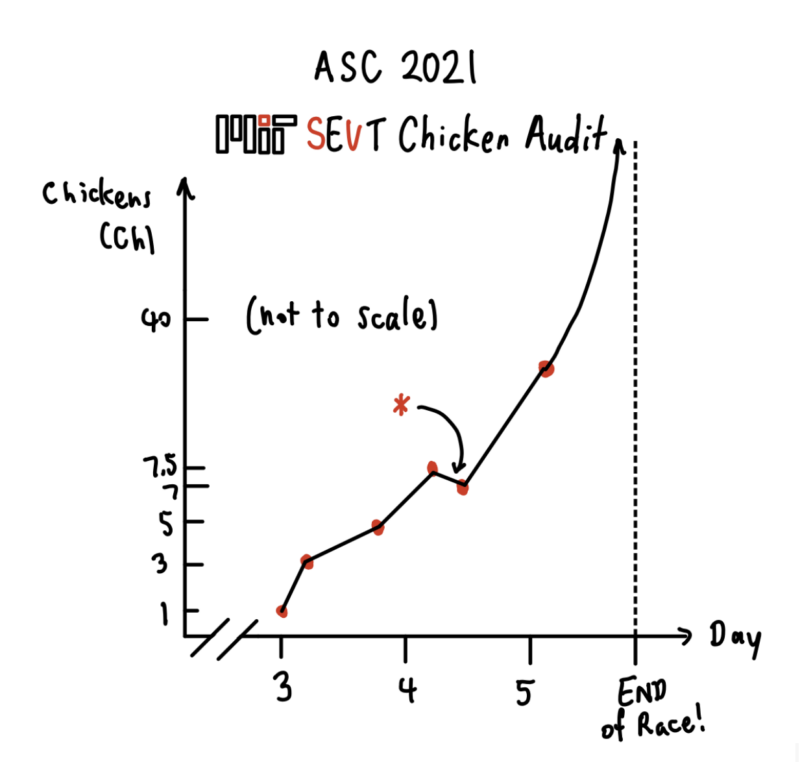
Figure 2. A plot of measurements by our chicken-meter over the duration of the ASC 2021 race.
* Heavy traffic in the city made us revise down our expectations for the number of loops we could complete, so our chicken count decreased slightly. “I ate half of a chicken” – Julian
By Day 5, the last day of the race, we were pretty far ahead of the rest of the teams competing at ASC, so we were bold with our chicken estimate, going up to a whopping 40 chickens at the start of the day. “Wow, that’s a lot of chickens!” – Max B., ‘2415 EE member
When the final results of the race came in at the end of Day 5, we found out that we officially won the single-occupant vehicle class at ASC 2021! Our chicken-meter reached its operational limit, so we naturally rounded up to infinite chickens, because that’s how measurements work right?
Now that we’re back at MIT with our lifetime supply of poultry, we are expanding the SEVT shop in N51 to serve more members of our community. Come buy some chicken and help us fund our first ever multi-occupant vehicle, or join the team and get free chicken on Saturdays!
Stoney Creek Hotel Break in – Julian Z ‘23, EE
We were in our room on the second floor of the Stony Creek Hotel in Independence, Missouri. It was 1:00 AM, and ASC would start the next morning (or that morning, depending on how you look at things). As the two members of MIT’s StrategEE team,16 The StrategEE team is responsible for determining the optimal way for Nimbus to drive (particularly in terms of speed) to maximize distance traveled over the five days of the race. To meet both of these goals, we have to consider weather conditions, elevation changes, Nimbus' energy quota, and so on. Jenny and I were the last two awake. We were slogging through weather forecasts, route information, and battery characterization curves, but in the hopes of providing our teammates with favorable sleeping conditions, we kept the lights off and spoke in whispers.
But the night was anything but silent. The shrill call of cicadas offered a sense of solidarity, reminding me that we weren’t the only ones awake at this late hour. The frantic clicks of our keyboards built a sense of tension, reminding me that we were running out of time. And the relentless hum of Nimbus’ battery fans as it charged off the wall17 We were allowed to charge Nimbus' battery through an outlet before the race started, but once the event begins, the car must rely entirely on solar energy. for the final time established a sense of unity with our beloved solar car. Nimbus was preparing for the moment of truth, and so were we.
I fought back stress, fatigue, and gastrointestinal distress (I had eaten my Chipotle dinner18 Chicken bowl with brown rice, pinto beans, pico de gallo, corn, cheese, and lettuce. Also, did you know that Chipotle's cheese blend is a mix between white cheddar and Monterey Jack? (Unless they were lying to me...) way too fast), but slowly, cortisol was building… and that cortisol burst into adrenaline as I heard a sudden, sharp sound behind me.
KNOCK, KNOCK, KNOCK!
Oh, it’s just the door. I took a deep breath as my heart rate slowed again, popped up to my feet, glanced out the peephole, and saw an MIT SEVT T-shirt. Another teammate probably left their charger or something in this room. I swung the door open.
And before me stood a man who I had never seen before in my entire life. Stranger Danger at 1:00 AM. My body tensed as I locked my focus onto him.
“Hellooooo!” His enthusiasm took me off guard; it was as though we had known each other our entire lives.
“Hello,” I replied. I attempted to reply with similar enthusiasm, but a hint of a smile never crossed my face. I was too busy asking myself questions like, “Who on earth is this man? How did he acquire an MIT SEVT T-shirt? Did he follow the team to this hotel? Is he a scout for another team trying to collect data on us?”
So we just stared at each other for a good five seconds. The silence was deafening. The look of distrust on my face must have been evident, but the mystery man was wholly undeterred.
“Helllloooooooo!” he repeated. Still joyful, but more insistent this time.
“Hi,” I replied. The cortisol was rushing back, this time paired with adrenaline. What does he want from us, especially at this hour?
“Hellllllooooooooo!” One final time. But this time was different. This time, he made a move towards the room, as though to enter.
This was a declaration of war. This is not the move of an undercover scout; this is the move of someone with far more sinister goals. It’s late, I’m tired, I don’t know your intentions, and I’m the only thing standing between you and four of my friends in this room. Do your worst, but you shall not pass!
As I rushed to block the entryway with the right side of my body, I began charging a surprise electrified ki blast with my left hand,19 All MIT EE's learn this technique in 6.9000+, 'Corporeal Capacitance and its Combat Applications.' which was still hidden behind the door. The room was illuminated as the ball of energy swelled to the size of a coconut, and a faint crackling sound grew louder as static electricity began jumping across the surface of the orb. But just before I released the attack, the words of a Slack message that the team had received ninety minutes earlier came rushing back to my head:
“Waly N. (11:13 PM): Hello can someone help me know what rebecca’s dad looks like?”
This mystery man had to be Waly! There was some talk I heard in passing about Waly being on schedule to arrive that night. It must have been Rebecca’s father who was going to pick him up from the airport. Presumably, he had been dropped off here at the hotel a few minutes ago.
“Oh, you must be Waly!” I said.
“Yeah!” Waly replied, still enthusiastic.
We happily shook hands as I furtively extinguished my ki blast, which was still hidden behind the door. “Sorry!” I laughed, relieved by the revelation. “I had no idea who you were!” Even though I’d heard from him many times in team meetings over Zoom, I had never once seen Waly’s face;20 I understand that MIT bloggers have portraits on their posts, but I confess that haven't read MIT blogs since I was admitted. Now I know the dire consequences that that can have. his camera was always deactivated, and his profile picture was not a picture of him, but rather of an adorable, mildly rotund beaver. But finally, I had a face to put to the name.
I welcomed him inside, showed him to his bed, and regrouped with StrategEE to finalize our plan. All was well, and the rest is history.
Except for maybe the part where David, who had slept through the whole ordeal, rolled over in his bed, which had been entirely vacant just a couple of hours ago, only to be awakened by a collision with the body of a mystery man. The mystery man fell back asleep, but David was shaken and remained awake for hours as he pondered the man’s identity.
I’ll leave that story for another time.
Honorable Anecdotes – Some stories that did not get to see their full glory
Delivered to you in one sentence of context…
-
Izod Impact Strength Test…. with a sledgehammer
- When the judges ask a group of MIT students to prove our windshield strength, we create a whole jank lab in our garage to prove our windshield strength
Array dance
- Our daily ritual begging the sun to bless us with power for NImbus
- Support vehicle keys
- It is much harder is it to lose keys on a random train track in Kansas than you would expect
- Solar car stretches
- On a dirt road in New Mexico, each SEVT member comes up with a stretch to keep all the other members fit for the rest of the race
- Topher from Kentucky
- A legend
- Scout scout scout scout
- Scout scout scout scout, a mysterious language only members of the scout car could understand
- Liz & Ducky
- Our adorable mascot Liz, and Ducky, two stuffed companions that were with us the whole route from Missouri to New Mexico
- What a good girl back to text ↑
- not sure because the midwest isn't even really in the middle/west of America... back to text ↑
- who I kind of stole the blog from, oopsies back to text ↑
- it will be quick, he lied. back to text ↑
- Home to Flint Hill Books, the nicest bookshop I've ever been to back to text ↑
- Nimby, I don't think we're in Kansas anymore. Also, the geography nerd in me feels compelled to tell you, this used to be the southern border of the US back to text ↑
- Not the Sin City you are thinking of... back to text ↑
- Technically they weren’t antelope. I later learned that antelope are not native to the Americas and these animals were pronghorns, a native species very similar to antelope and often commonly referred to as antelope or “pronghorn antelope.” For the sake of this post, I will simply call them antelope as that’s what we used on the race. back to text ↑
- The opposite of a rain-dance back to text ↑
- Our retired team captain back to text ↑
- The race official traveling with us on the race (Keenan) who makes sure we follow regulations and traffic laws watches us lock our battery pack into an impound box every night to make sure we don't secretly charge it off the wall during the night. back to text ↑
- This component displays information like voltage of the battery, current going in from the array and out to the motor, and velocity of the car. back to text ↑
- At noon on a nice sunny day, we can get to about 7 amps, and when the sun is lower in the sky and there is some amount of morning fog, 3 amps is a very good number. back to text ↑
- The other strategEE sitting next to me in the chase vehicle back to text ↑
- EE member back to text ↑
- The StrategEE team is responsible for determining the optimal way for Nimbus to drive (particularly in terms of speed) to maximize distance traveled over the five days of the race. To meet both of these goals, we have to consider weather conditions, elevation changes, Nimbus' energy quota, and so on. back to text ↑
- We were allowed to charge Nimbus' battery through an outlet before the race started, but once the event begins, the car must rely entirely on solar energy. back to text ↑
- Chicken bowl with brown rice, pinto beans, pico de gallo, corn, cheese, and lettuce. Also, did you know that Chipotle's cheese blend is a mix between white cheddar and Monterey Jack? (Unless they were lying to me...) back to text ↑
- All MIT EE's learn this technique in 6.9000+, 'Corporeal Capacitance and its Combat Applications. back to text ↑
- I understand that MIT bloggers have portraits on their posts, but I confess that haven't read MIT blogs since I was admitted. Now I know the dire consequences that that can have. back to text ↑
